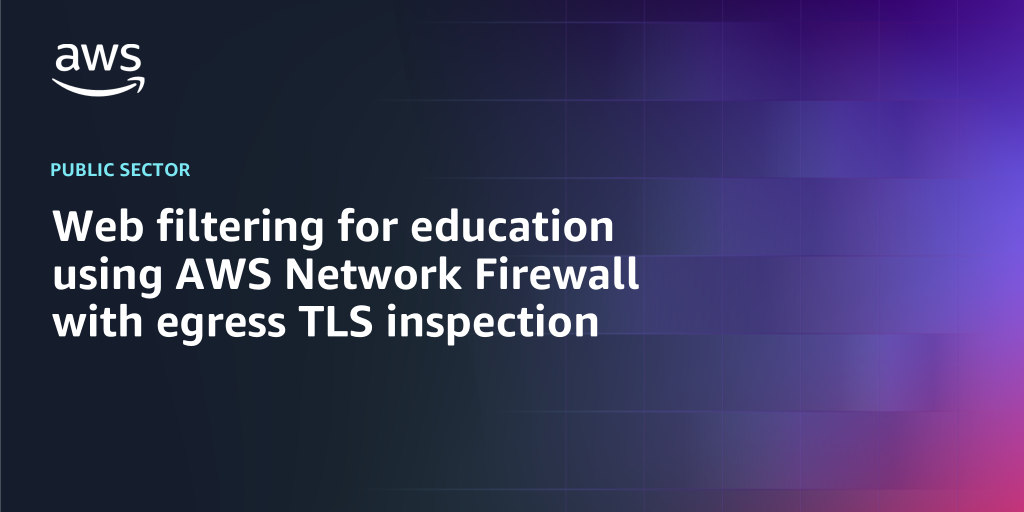AWS Public Sector Blog
Tag: education
Web filtering for education using AWS Network Firewall with egress TLS inspection
This post demonstrates how TLS inspection in Network Firewall provides visibility into encrypted traffic, even when browsers implement Encrypted Client Hello (ECH) or when SNI fields contain modified information.
Renaissance uses generative AI on AWS to accelerate personalized learning at scale
As a global leader in K12 educational technology (EdTech) solutions, Renaissance supports over 16 million students across more than 100 countries with a mission to improve learning outcomes for all students, regardless of ability or background. Its data-rich platform helps educators make informed decisions and deliver personalized learning experiences for students. Read this post to discover how Renaissance worked with AWS to develop a scalable, human-in-the-loop solution powered by generative AI.
Pearson at AWS DC Summit 2025: Transforming education through AI-powered learning solutions
During the 2025 AWS Summit in Washington, DC keynote address, Amazon Web Services (AWS) and Pearson showcased the strength of their expanded collaboration to accelerate the development of AI-powered, personalized learning solutions.
Research at the speed of discovery: AWS cloud bursting eliminates computational bottlenecks
AWS has leveraged the expertise of Pariveda Solutions, an AWS Premier Consulting Partner, to develop a flexible high performance computing (HPC) bursting solution that dynamically extends your on-premises infrastructure into the cloud. This approach provides stable core HPC infrastructure with the flexibility to handle peak demand without massive capital investments.
Zearn boosts math accessibility with Amazon Polly’s AI-powered text-to-speech
Read this post to learn how Zearn improved students’ learning experience with Amazon Polly, a scalable, high-quality text-to-speech (TTS) solution from AWS that offers human-sounding voices, Spanish-language support, and seamless API integration.
Empowering educators in Türkiye with AI: Öğretmen Plus
Leading EdTech company Doping Hafıza is revolutionizing how teachers work through Öğretmen Plus, an Amazon Bedrock-powered solution. Öğretmen Plus is a social responsibility project aimed at reducing teachers’ workloads by making lesson planning more efficient and effective for more than one million K–12 teachers across Türkiye.
Unlocking the archive with generative AI: How The Chronicle of Higher Education built Chron with AWS
In this post, we explore how The Chronicle of Higher Education harnessed the power of generative AI and Amazon Bedrock to build Chron: a search assistant that unlocks the full value of The Chronicle’s rich archive for educators, administrators, and all higher-education professionals.
Unlocking student success with generative AI: How Panorama Education built Solara on AWS
With over a decade of experience supporting more than 2,000 school districts across North America, Panorama Education had already built powerful tools for integrating academic, attendance, behavior, and life skills into one unified view of student progress. To unlock the value of that data securely, Panorama built Solara, a generative AI platform built on AWS. Solara is designed to help educators make sense of student data faster, design personalized student improvement plans, and reduce administrative burden while maintaining trust and data privacy at scale.
Indiana University streamlines social science research with secure automated transcription on AWS
To help researchers reclaim their time and focus on discovery, Indiana University developed a secure, scalable, and cost-effective Automated Transcription Service (ATS) built on AWS. Since launching, the service has supported nearly 60 projects across 16 departments and has become a model for how universities can use cloud-native tools to affordably streamline research workflows and protect sensitive data.
From local servers to global impact: How Learning Upgrade uses AWS to reach millions of learners in need
Learning Upgrade worked with AWS to modernize its platform and ultimately migrated fully to the cloud. This strategic shift empowered Learning Upgrade to scale globally, respond faster to new opportunities, and better serve learners in dynamic, resource-constrained environments. Read this post to learn more.









